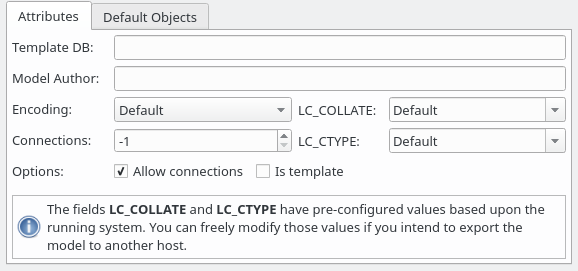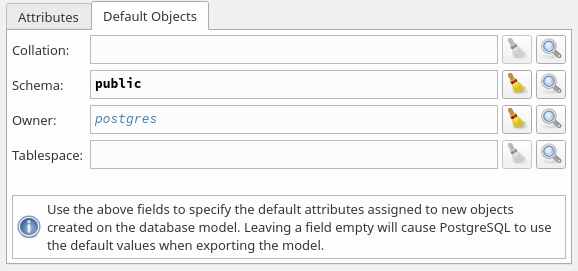3.1. Database
This object is the basis of modeling and represents the database to be created in a PostgreSQL server as well as the model itself. All objects manipulated in pgModeler are directly or indirectly linked to it meaning that some operations applied to a database object can affect some of its children. Database objects are unique instances and can't be copied from one model to another. The first tab of the database's dialog contains the following attributes:

| Attribute | Description |
|---|---|
Template DB |
The name of the template from which create the new database. If this field is left empty then the default template (template1) is used. |
Model Author |
Name of the person who designed the model. The value specified here will be shown as a comment entry in the SQL definition. |
Encoding |
The charset to be used in the database. If the Default value is used then the charset will be configured by PostgreSQL depending on its settings. |
Connections |
The number of simultaneous connections which the database accepts. The default value 1 indicates that there is no limit for concurrent connections. |
LC_COLLATE |
Specifies in which language the string sorting must be applied. The values listed in this field are platform-dependent so if you don't know what value to use it's safe to leave it as Default. You can even specify a value not listed in this field, just type the desired value then it'll override any value configured previously. |
LC_CTYPE |
Specifies in which language the character categorization (upper, lower, and digit) must be applied. The values listed in this field are platform-dependent so if you don't know what value to use it's safe to leave it as Default. You can even specify a value not listed in this field, just type the desired value then it'll override any value configured previously. |
Allow connections |
Indicates if the database should permit clients to connect to it. |
Is template |
Indicates if the database is a template one. |
There is another tab in the database editing form where default objects can be configured. Default objects are the ones that will be assigned to objects each time a new one is being constructed. The default objects can be collation, schema, owner, and tablespace.

| Attribute | Description |
|---|---|
Collation |
Default collation assigned to any object created in the database model that makes use of this kind of object. |
Schema |
Default schema assigned to any object created in the database model that makes use of this kind of object. |
Owner |
Default owner assigned to any object created in the database model that makes use of this kind of object. |
Tablespace |
Default tablespace assigned to any object created in the database model that makes use of this kind of object. |
Mar 5, 2021 at 15:30